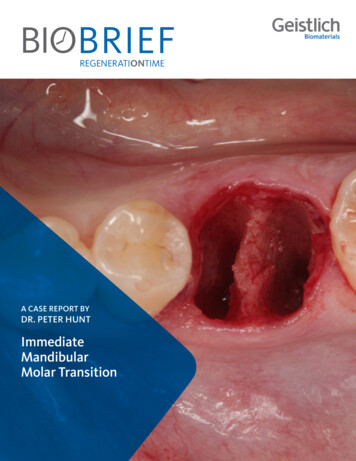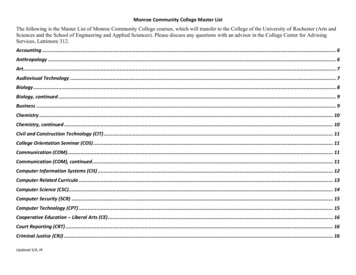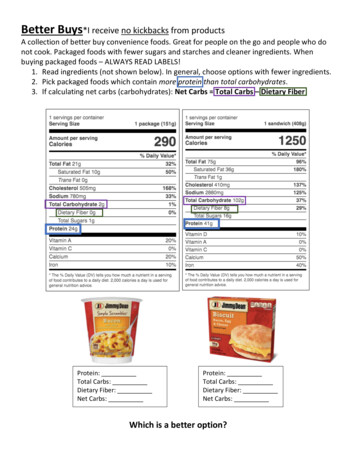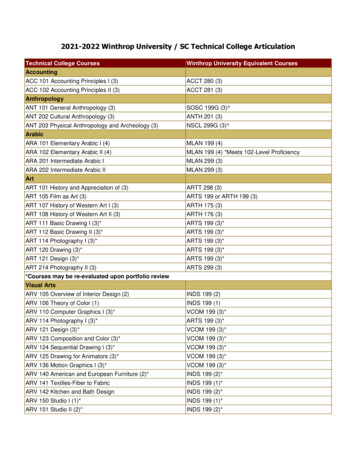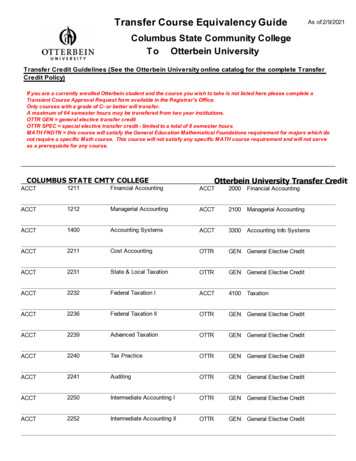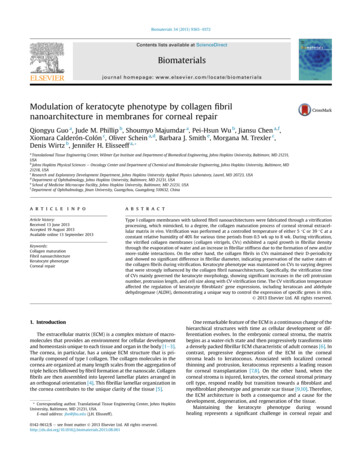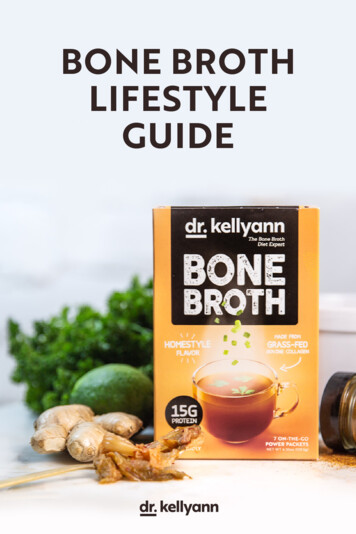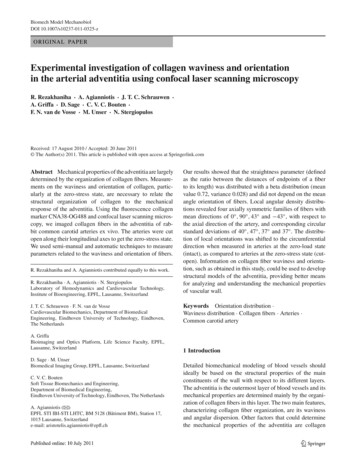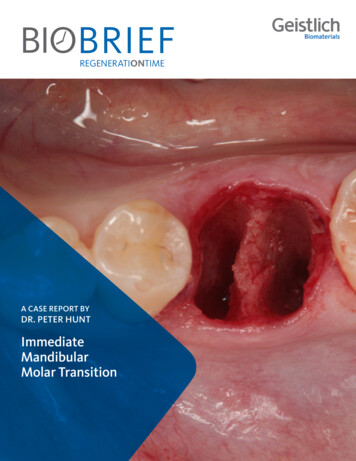
Transcription
REGENERATIONTIMEA Case Report byDr. Peter huntImmediateMandibularMolar Transition
REGENERATIONTIMEThe SituationThe case here is typical enough, a failing mandibular molar with a vertical sub-osseousfracture. Traditionally, the replacement process can take three or more surgical exposures(extraction and regeneration), (implant placement), (second stage exposure) and morethan a year of therapy.The Risk ProfileEsthetic Risk FactorsLow RiskMedium RiskHigh RiskPatient’s health Intact immune systemLight smoker Impaired immune systemPatient’s esthetic requirementsLowMediumHighHeight of smile lineLowMediumHighGingival biotypeThick - “low scalloped“Medium - “medium scalloped“Thin - “high scalloped“Shape of dental crownsRectangularInfection at implant sightNoneChronicAcuteBone height at adjacent tooth site 5 mm from contact point5.5 - 6.5 mm from contact point 7 mm from contact pointRestorative status of adjacent toothIntactTriangularCompromisedWidth of tooth gap1 tooth ( 7 mm)Soft-tissue anatomyIntactBone anatomy of the alveolar ridgeNo defectSPECIALINTERESTAugmentation inImplantology1 tooth ( 7 mm)2 teeth or moreCompromisedHorizontal defectVertical defect“The patient desires animplant placement for afractured mandibular„molar, as fast as possible.peter hunt, BDS, Msc, LDSRCS Eng Philadelphia, paPeriodontist - University of PennsylvaniaAfter graduate training on an Annenberg Fellowship at the University of Pennsylvania,Dr. Hunt helped start up the University of the Western Cape Dental School in Cape Town,South Africa. He returned to the University of Pennsylvania where in time he becameClinical Professor of Periodontics. Later he helped start up Nova Southeastern‘s DentalSchool where he was Professor of Restorative Dentistry, Post Graduate Director andDirector of Implantology. He has had a private practice in Philadelphia focusing onimplant and rehabilitation dentistry since 1981.
REGENERATIONTIMEThe ApproachImmediate molar replacement requires atraumatic removal of the fractured tooth, careful socket debridement and developmentof a channel for an ideally positioned implant. The implant then needs to be placed down in the bone channel with the implantplatform positioned just below the socket walls. It needs to be stable. Channel deficiency augmentation is achieved withGeistlich Bio-Oss Collagen which is covered with a collagen matrix, Geistlich Mucograft with the edges tucked underthe gingival margins and sealed over with tissue glue.123456781 A pre-operative radiograph and CBCT2 An implant site was developed by3 A Camlog 5.0 x 11 mm implant4 After placing a 4.0 mm height cylindrical-showing the cross-section of theplacing a pilot drill down the mesialwas placed with the platform setgingiva former in the implant, 250 mg ofinvolved tooth.root space, then uprighting it. Thisjust down below the bone heightGeistlich Bio-Oss Collagen was packedwas continued up through the drillof the socket walls.down in the socket around the implant.sequence. The mesial radicularseptum is moved in the process.5 Geistlich Mucograft was adapted to6 The gingival margins were adapted and7 4 months later followingEmergence Profile Development.8 An occlusal view of the final one-the region then tucked down underclosed together with 4.0 teflon suturesthe gingival margin.(Cytoplast , Osteogenics). The regionpiece, screw-retained zirconia crownrestoration based on a Camlog was then covered with Glustich -Titanium Base Abutment.PeriAcryl 90 Oral Tissue Adhesive.3 Month HealingHealing is welladvanced and readyfor EmergenceProfile Development“After 3 months of healing, the top ofthe gingiva former is exposed and thesituation is ready for Emergence Profile„Development. This is quite standard.The OutcomeThis single stage replacement protocol has proven to be simple, safe and highlyeffective providing the socket is fully degranulated and the implant is stableand not loaded in the early healing stages. It works well when a gingiva formeris immediately placed into the implant instead of a cover screw, GeistlichBio-Oss Collagen is packed around the implant to fill the residual socket,then covered with a Geistlich Mucograft and sutured. There is no needfor flap advancement to cover over the socket.
REGENERATIONTIMEBriefly SpeakingKeys to SuccessMy Instruments1. Atraumatic extraction2. Thorough degranulation anddebridement of the residual socket3. Adequate stability for the implant4. Placement of the implant platformdown just below the walls of the socket5. Placing a 4.0 mm height gingiva formerinstead of a cover screw6. Augmenting with Geistlich Bio-OssCollagen and covering withGeistlich Mucograft 7. No loading of the implant in theearly healing stagesA. EVO 15 electric micromotor handpiece for sectioningthe tooth (Bien Air)B. Ultrasonic periotome tips to loosen, flush and elevateout root tips (Mectron)C. OM1 hand held periotome to tweak out root fragments(Zoll Dental)D. Hand held curettes CL866 and excavators SPR 1/2 todegranulate and debride the socket (Hu-Friedy)E. iChiropro Implantology System for precision implantchannel preparation (Bien Air)F. #4 Molt Excavator (Zoll Dental)“The Ultrasonic Peritome tipshave made it significantlyeasier to remove teethatraumatically in„my practice.My Biomaterials Geistlich Bio-Oss Collagen hasexcellent handling and enhanced healingcharacteristics due to the addition of 10%collagen to the original Geistlich Bio-Oss granules. Geistlich Mucograft is specificallydesigned for soft-tissue regeneration. Thematrix properties provides closure and containsthe bone graft while allowing open healing aswell as the ingrowth of soft-tissue cells.GeistlichBio-Oss Collagen & Geistlich Mucograft A good combinationfor Extraction SocketManagement“This procedure really justmerges a socket regenerationprocedure with implant,placement. It s a simpleand effective procedurewhich has now become„quite standard for us.Geistlich Mucograft is measured,cut to size and placed directlyonto the defectGeistlich Mucograft in place,adapted to the defect andcompletely saturatedClick here to view the webinar
REGENERATIONTIMEABOUT BIOBRIEFWe know that exposure to new or refined treatment approaches brings innovation to practice.Geistlich Biomaterials is pleased to introduce a periodic opportunity to get up close and personalwith creative clinicians from around the world. Focused on peer-to-peer exchange, BIOBRIEFfeatures clinically relevant cases and techniques in specific therapeutic areas – highlightedwith valuable insights about materials and instrumentation, as well as keys to success.Geistlich Biomaterials – bringing you regeneration on time.The Therapeutic AreaIt is well documented that Geistlich biomaterials cansignificantly reduce the ridge resorption that typicallyfollows dental extractions. Procedures like the one shownhere by Dr. Hunt make it clear that in many cases it is possibleto place implants into extraction sockets before augmentingwith Geistlich biomaterials. This reduces surgical interventions,speeds therapy and minimizes ridge collapse.CAUTION: Federal law restricts these devices to sale by or on the order of a dentist or physician.Indications:Geistlich Bio-Oss Collagen is indicated for the following uses: Augmentation or reconstructive treatment of the alveolar ridge; Filling of periodontal defects; Filling of defects after root resection, apicoectomy, and cystectomy; Filling of extraction sockets to enhance preservation of the alveolar ridge; Elevation of the maxillary sinus floor; Fillingof periodontal defects in conjunction with products intended for Guided Tissue Regeneration (GTR) and GuidedBone Regeneration (GBR); and Filling of peri-implant defects in conjunction with products intended for GBR.Indications:Geistlich Mucograft is indicated for the following uses: Covering of implants placed in immediate or delayed extraction sockets, localized gingival augmentation to increase keratinized tissue (KT) around teeth andimplants, alveolar ridge reconstruction for prosthetic treatment, recession defects for root coverage.Warnings:As Geistlich Mucograft is a collagen product allergic reactions may not be totally excluded. Possiblecomplications which may occur with any surgery include swelling at the surgical site, flap sloughing,bleeding dehiscence, hematoma, increased sensitivity and pain, bone loss, redness and local inflammation.For more information on contraindications, precautions, and directions for use, please refer to theGeistlich Bio-Oss Collagen and Geistlich Mucograft Instructions for Use at: www.geistlich-na.com/ifu 2017 Geistlich BiomaterialsWarnings:Possible complications which may occur with any surgery include swelling at the surgical site, flap sloughing,bleeding, local inflammation, bone loss, infection or pain. As Geistlich Bio-Oss Collagen contains collagen,in very rare circumstances cases of allergic reactions may occur.GB-1044b-17EGeistlich Pharma North America, Inc.202 Carnegie CenterPrinceton, NJ 08540Customer Care Toll-free: com
follows dental extractions. Procedures like the one shown here by dr. hunt make it clear that in many cases it is possible to place implants into extraction sockets before augmenting with Geistlich biomaterials. This reduces surgical interventions, speeds therapy and minimizes ridge collapse. Geistlich pharma North America, Inc. 202 Carnegie Center
